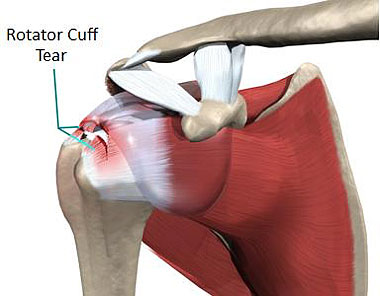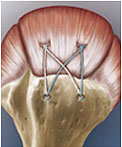Rotator Cuff Disease
Rotator cuff disease is a painful condition involving the shoulder. The rotator cuff consists of four muscles that originate on the shoulder blade (scapula) and attach to the top of the arm bone (humerus). The rotator cuff serves several functions. It keeps the ball centered in the socket of the shoulder joint, it provides dynamic stability to the shoulder, it helps with raising the arm overhead, and it helps with arm rotation. When the rotator cuff tears, it produces pain and weakness in the shoulder. Common symptoms include pain and weakness with recreational activities, lifting objects, reaching overhead, and pain at night when sleeping on that side. Rotator cuff tendonitis and tears are the most common cause of pain in the shoulder.
How does this happen?
Rotator cuff tendonitis and rotator cuff tears both cause pain. Tendonitis is inflammation in the tendon, and a tear is when the tendon pulls off from the boney attachment. Rotator cuff tendonitis and tears can be caused by many factors, including trauma, an injury to the shoulder, lifting something heavy, and repetitive overhead activities. Rotator cuff tears can also develop with normal wear and tear of daily life, without an injury, as the blood supply to the rotator cuff decreases with age.
How will we know that this is your problem?
The diagnosis of rotator cuff disease is made through a combination of history and physical exam. History may include a specific injury, but pain can also develop slowly over time without a traumatic injury. Examination of the shoulder will reveal swelling and tenderness over the rotator cuff, pain with certain provocative maneuvers, and weakness with specific testing of the different rotator cuff muscles. The diagnosis can be confirmed with an MRI of the shoulder.

Normal Shoulder
How can this be treated?
The initial treatment for rotator cuff tendonitis or tears involves a period of rest and anti-inflammatory pain medication (NSAID’s). The mainstay of treatment involves physical therapy or home exercises for rotator cuff strengthening and strengthening of the shoulder blade muscles. Cortisone injections may be very helpful. When non-operative treatment fails to provide pain relief, surgery may be necessary. Surgery can be performed arthroscopically (using a scope) to repair the torn rotator cuff and remove any bursitis and bone spurs. Surgery is typically performed as an outpatient, and you can go home the same day.


Dr. Michael O’Brien performs arthroscopic surgery for rotator cuff tears, and is fellowship trained in the field of shoulder surgery and shoulder reconstruction. Dr. O’Brien has tremendous success in improving patients’ pain and returning them to their normal activities with arthroscopic rotator cuff repair (see below for recent publications).
The Tulane Institute of Sports Medicine offers on-site X-Ray and MRI, as well as its own Physical Therapy department with licensed physical therapists, in order to ease your visit and speed your recovery.
¹Arthroscopic repair of large and massive rotator cuff tears. Arthroscopy. 2003; 19(6):564-571.
²Rotator Cuff Tendinopathies and Tears: Surgery and Therapy in Rehabilitation of the Hand and Upper Extremity (6th Ed.), Skirven TM, Osterman AL, Fedorczyk JM, Amadio PC, Eds., Elsevier/Mosby, 2011, pp 1157-1173.
